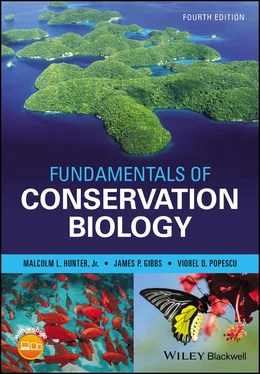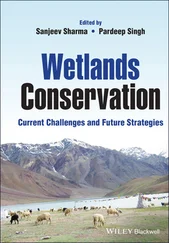Table 5.1 Distribution of two alleles, MDH‐1 xand MDH‐1 y, among five bison.
Source : Based on McClenaghan et al. 1990.
| Bison |
X allele |
Y allele |
Genotype |
| A |
1 |
1 |
X/Y |
| B |
1 |
1 |
X/Y |
| C |
0 |
2 |
Y/Y |
| D |
0 |
2 |
Y/Y |
| E |
2 |
0 |
X/X |
| Total |
4 |
6 |
|
| Gene frequency |
0.4 |
0.6 |
|
Although it is common for a single allele to comprise close to 100% of any gene that is not polymorphic, very few genes consist of absolutely 100% of a single allele. If you search a large enough sample of individuals, you are likely to find rare alleles . Rare alleles are defined as having a frequency of less than 0.005, 0.01, or 0.05, depending on the techniques employed and how the information is being used. Most of these rare alleles linger in populations but have no fitness advantages for individuals that possess them. However, these rare alleles can suddenly become the grist for evolutionary change, that is, they represent the latent variation in populations that becomes valuable when the environment changes. Turning back to the gray squirrel (see Fig. 5.3), the species was once comprised almost entirely of the darker morph in the old growth forests of North America (so alleles associated with gray coats were rare) (Schorger 1949). Due to selection against the darker morph by hunters and forest destruction following European colonization, the darker morph virtually disappeared. Now the dark morph, and the allele that generates them, are very rare in most populations except urban ones. With hunting declining and urbanization spreading, the now rare allele associated with the darker morph may become more widespread again.
Finally, we need to emphasize that polymorphism is usually based on the distribution of alleles, not genotypes. This means that given a population without any heterozygotes, a gene could still be polymorphic. To return to our bison example, a population of four homozygous Y/Y bison plus one homozygous XIX bison would be polymorphic at this locus, and P would still be 4.2%.
Genotypic diversity is the number of different allele combinations in a population. It can be an important consideration in itself because different alleles in combination generate different interactions and phenotypes. Returning to the bison example, consider the three genotypes: X/X , X/Y (same as Y/X ) and Y/Y . Genotypic diversity refers to the number and distribution of individuals across these genotypes. If most individuals in the population were X/X (or X/Y or Y/Y ), then the bison population would have low genotypic diversity. If individuals were well distributed across the three genotypes then genotypic diversity would be high (these are very similar concepts for measuring species diversity and evenness discussed in Chapter 3). In the context of more loci and more alleles associated with each, you can imagine that many unique combinations among them and hence genotypes will be manifested.
Why is genotypic diversity relevant? Genetic variability imparts adaptability. Consider seagrass, an important plant of tidal environments, as an example. Replicated plots in the Baltic Sea were planted with one, three, or six genotypes. An unprecedented heat wave occurred during the experiment. Recovery following the heat wave was much better in the plots with seagrass of multiple genotypes (Reusch et al. 2005). Genotypic diversity is also important for economic and cultural reasons. The columnar cactus is used in Central Mexico for its edible fruits. Consumers prefer some cactus genotypes more than others based on the flavor, shape, and color of fruits associated with each. The process of bringing cacti from the wild into cultivated populations has created new genotypes and, interestingly, also enhanced genotypic diversity in the wild when cultivated forms (and the new genotypes they represent) are replanted back in the wild (Casas et al. 2006).
Another index, called heterozygosity (usually abbreviated H), is defined in two ways. The most typical is the proportion or percentage of genes at which the average individual is heterozygous. The second is the proportion of individuals in a population heterozygous for a particular gene (Hartl and Clark 1997). In the bison example, two out of five individuals were heterozygous at the MDH‐1 locus, so heterozygosity 2/5 = 0.4 for this gene. We can calculate H by averaging the heterozygosity of each gene across all 24 genes. In this case,

Three uses of heterozygosity measurements merit mentioning. First, geneticists often compare the heterozygosity that they measure – the observed H, or H o– with the heterozygosity they would expect to find, H e, given the relative or “background” frequency of alleles. The expected heterozygosity is calculated by using the middle component (2 pq) of the Hardy–Weinberg equation, p 2+ 2 pq + q 2= 1. In this example, given a frequency of p = 0.6 for the Y allele and q = 0.4 for the X allele (see Table 5.1), the Hardy–Weinberg equation is

Consequently, H efor MDH‐1 is 0.48 (2 × 0.6 × 0.4 = 0.48). The H ebased on all genes for these five bison is 0.48/24 = 0.02, which is close to the H oof 0.017. So in other words, the bison population is likely operating as if most individuals were reproducing and interacting with one another, as you would hope for in a healthy herd. But what if only a few females are producing most of the calves? Or just one male? H owould depart strongly from H e.In a small population this can be problematic as generally we seek genetic contributions from most individuals to preserve what genetic variation remains. Departures of H ofrom H ecan therefore provide a useful and quick glimpse into a population’s reproductive dynamics, and point to management actions to address problems revealed. We expand on this issue further on in this chapter.
Another use of the heterozygosity index relates to its other interpretation: average diversity within an individual. Generally speaking it “helps” to be a heterozygote, that is, to have different versions of each gene present in your genome. You are a good example: your long developmental trajectory from an embryo in your mother’s womb (during a short period of which you even had gills and appeared much like a larval fish) to the bipedal adult ape you now are is a long one during which you faced many different physiological challenges. Having different gene forms (alleles) to “call on” as you developed through these phases (some alleles are more useful than others at different developmental stages) helped buffer your development from environmental stresses along the way. Fish present another good example. A large body of research on rainbow trout (Allendorf et al. 2015) has shown a positive correlation between heterozygosity and developmental stability (particularly how symmetrical the trouts’ bodies are – important in fish for moving through water in a streamlined manner). The reasons for these relationships are still not well understood (Miklasevskaja and Packer 2015) but correlations between fitness of individuals, symmetry, heterozygosity, and stress seem widespread in many organisms (de Anna et al. 2013), including humans (Trivers et al. 2013), but not always (e.g. in frogs: Eterovick et al. 2016).
Читать дальше














